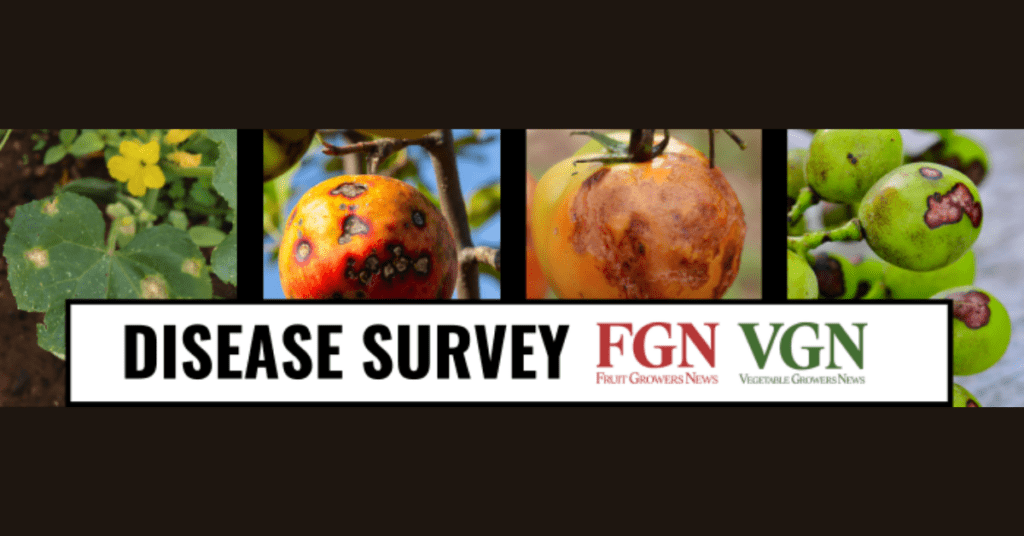
Feb 28, 20252025 disease survey report: Growers provide insight into disease challenges
The challenges from disease continue for vegetable, tree fruit, berry, grape and melon growers across the nation. The upcoming season could be filled with challenges from disease.
A recent survey conducted by Vegetable Growers News revealed some insights on the most prevalent disease issues and concerns, as well as the type of support growers are seeking to combat the hurdles caused by damaging diseases.
Crop challenges In the survey, conducted in late 2024, fruit and vegetable growers listed more than 30 diseases they battle, from anthracnose to neopestalotiopsis, also known as pestalotia leaf spot and fruit rot on strawberries.
Polled about the most significant disease challenges they face, growers listed an array of diseases, including blights, mildews, rots and rusts. The percentages listed in the results represent the distribution of disease mentioned by the respondents. Each disease contributes equally to the total, regardless of whether it was mentioned once or multiple times in different responses.
Fire blight emerged as the biggest identified disease threat, with up to 20% of respondents stating the disease can kill apple trees and entire orchards, and was the most troublesome to their growing. In addition to apples, fire blight also damages pears, raspberries and other rose family plants.
Downy mildew was listed by 18% of respondents as the second most troublesome disease. Powdery mildew was third-most troubling to their groves, vineyards and fields at 16%.
Anthracnose and scab each polled at 12.7% as most troublesome, with phytophthora rated at 11%. Botrytis and bacterial spot respectively polled at 7%.
Bitter rot rated at 4% of those surveyed. However, all of the rots combined, including brown rot, soft rot, crown rot and leather rot, constituted 25% of responses.
Combining all other blights listed — including early and late blight, GSB (gummy steam blight or black rot), leaf blight, tomato blight, sclerotinia and cane blight — blight, as a category, represented 11% of responses.
2025 worries
As 2025 progresses, growers anticipate continued challenges from disease. Growers were most concerned about fire blight at 12%, powdery mildew and scab at 11% and the following diseases all at 7%: alternaria (black spot), a fungus that causes leaf spots, blights and rots on numerous plants, anthracnose and downy mildew.
All rots combined constituted 13% of responses.

Combining all blights listed as a category represented 7% of responses that growers listed as most concerning diseases for 2025.
Other diseases reported by growers as most troublesome included alternaria or black spot, fusarium and bacterial wilt, marssonina, red and sooty leaf blotch viruses, mold, BLS (bacteria leaf streak), mummy berry (a fungal disease common among blueberry species), bacterial canker, glomerela (apples), cranberry false bottom, cucumber virus, pythium, vector in winegrapes, x-disease (western x) and northern corn leaf blight.
To help better manage disease, growers ranked where they prefer to receive updated disease management practices information. On a scale of 1 being the most important and 5 being least, growers rated university Extension personnel at the top (55%). Other sources of disease information included crop protection companies/field reps (14%), other growers (11%), industry magazines (9%), social media, government resources, and trade shows and conventions at 4%.
When queried about information publications could provide them that would be helpful in addressing the disease issues they face, growers listed these topics:
- New control materials
- Fungicide updates
- Inexpensive management/ treatment options
- Resistance management
- Resistant varieties
- Biological and conventional control methods
- Organic controls
- The latest BMPs for downy mildew and various tomato diseases
- How fertility can help mitigate disease
- Best timing of chemical applications
Tomatoes, cucumbers, peppers, pumpkins, squash, cabbage, with onions, leafy greens, broccoli and melons tied for 7th place, with carrots, sweet corn, potatoes, cauliflower, strawberries, asparagus and sweet potatoes among the primary crops grown by respondents.
However, a notable diversity in crops was also observed among survey participants, with some growers also cultivating herbs, peas, garlic and okra.
Of those surveyed, an overwhelming majority of growers (71%) grew fewer than 100 acres, with 16% growing 100 to 499 acres. Up to 100% of survey respondents stated they grow in fields, with 24% stating they grow in high tunnels/hoop houses, 14% in greenhouses and 7% hydroponically.
— Doug Ohlemeier, Assistant Editor
















